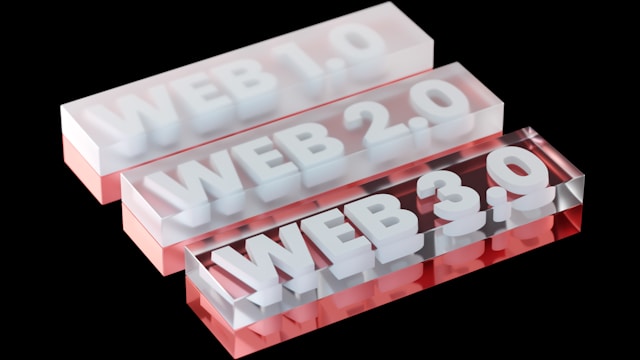The internet has transformed dramatically since its early days. What started as a simple, static network of web pages has evolved into a dynamic, interactive, and now decentralized ecosystem. To better understand this progression, it’s essential to explore the difference between Web 1.0, 2.0, and 3.0. Each version represents a significant shift in how people interact with the internet, how data is managed, and how technology shapes our online experiences.
What is Web 1.0?
Web 1.0 refers to the earliest stage of the internet, spanning the 1990s to the early 2000s. This was the era of the “read-only” web, where websites were static, and content was created and controlled by website owners. Users could view information but had little to no ability to interact with it.
Key characteristics of Web 1.0 include:
-
Static web pages built with HTML
-
Limited interactivity and no user-generated content
-
Centralized control where companies or individuals published information
-
Text-heavy design with minimal graphics or multimedia
Examples of Web 1.0 include early search engines like Yahoo Directory, static company websites, and personal web pages hosted on services like GeoCities. While basic, Web 1.0 laid the foundation for the evolution of the internet.
What is Web 2.0?
Web 2.0 emerged in the early 2000s and continues to shape the internet we use today. Unlike the static nature of Web 1.0, Web 2.0 is known as the “read-write” web. This stage introduced dynamic content, interactivity, and most importantly, user-generated content.
Key characteristics of Web 2.0 include:
-
Social interaction and collaboration through platforms like Facebook, Twitter, and YouTube
-
User-generated content such as blogs, wikis, and reviews
-
Mobile internet and apps making the web accessible anywhere
-
Rich multimedia experiences with videos, images, and interactive tools
-
Centralized platforms where companies like Google, Meta, and Amazon control large amounts of user data
Examples of Web 2.0 include Wikipedia, social media platforms, e-commerce sites, and blogging networks. While Web 2.0 revolutionized communication, it also raised concerns about data privacy, centralization, and the dominance of tech giants.
What is Web 3.0?
Web 3.0, often called the “semantic web” or the “decentralized web,” is the next phase of internet evolution. It is still emerging but already changing how people interact online. The main focus of Web 3.0 is decentralization, user empowerment, and smarter data usage.
Key characteristics of Web 3.0 include:
-
Decentralization: Data stored on blockchain instead of being controlled by corporations
-
User ownership of data: Individuals have more control over their digital identity and privacy
-
Artificial intelligence and machine learning: Smarter search engines and personalized experiences
-
Semantic web technologies: Better understanding of context and meaning in search queries
-
Cryptocurrencies and NFTs: Financial systems built on blockchain technology
-
Immersive experiences: Virtual reality and metaverse platforms
Examples of Web 3.0 include decentralized applications (dApps), blockchain networks like Ethereum, NFT marketplaces, and metaverse platforms such as Decentraland. While Web 3.0 offers many promises, challenges like scalability, regulations, and mainstream adoption remain.
Key Differences Between Web 1.0, 2.0, and 3.0
To clearly understand the difference between Web 1.0, 2.0, and 3.0, here’s a comparison of their core features:
Feature |
Web 1.0 (1990s–2000s) |
Web 2.0 (2000s–Present) |
Web 3.0 (Emerging) |
|---|---|---|---|
Interaction |
Read-only |
Read-write (interactive) |
Read-write-own (decentralized) |
Content |
Static, published by few |
Dynamic, user-generated |
Semantic, AI-driven |
Control |
Centralized, website owner |
Centralized, big tech companies |
Decentralized, blockchain |
Technology |
HTML, basic web servers |
Social media, cloud, mobile |
Blockchain, AI, semantic web |
Examples |
Yahoo, GeoCities |
Facebook, YouTube, Wikipedia |
dApps, NFTs, metaverse apps |
Why Web 3.0 Matters for the Future
The rise of Web 3.0 has significant implications for the future of the internet. Unlike previous versions, Web 3.0 focuses on giving power back to users through decentralization and privacy. With blockchain technology, individuals can own their data, manage digital assets, and participate in decentralized finance without relying on traditional banks.
Artificial intelligence and semantic search will also make the internet more intuitive, helping users find information more quickly and accurately. However, challenges like regulation, energy use in blockchain systems, and mass adoption must be addressed before Web 3.0 becomes mainstream.
Conclusion
The evolution of the internet can be summed up as a journey from static to interactive, and now, to decentralized. Web 1.0 introduced static information sharing, Web 2.0 revolutionized interactivity and user content, and Web 3.0 is shaping a decentralized, intelligent, and user-driven digital world.









